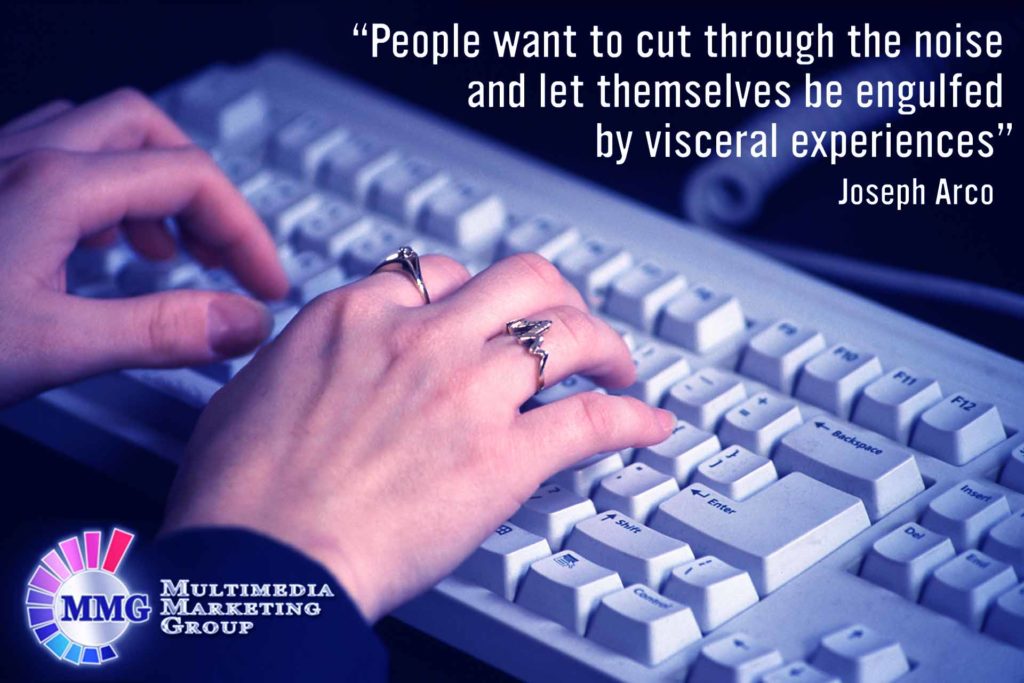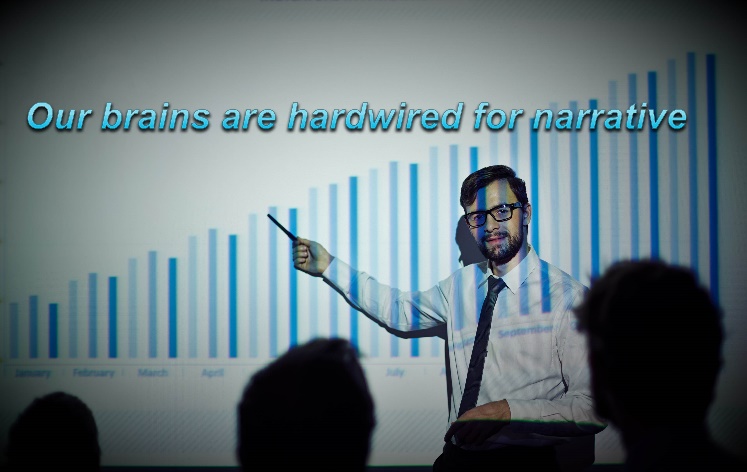
September 3, 2018
Culturally, biologically and neurologically speaking, instinctively we recognize that storytelling is an amazingly powerful tool and a very persuasive one at that. All of us, at one time or another, have watched or listened, to a great Ted Talk, or at a seminar, or conference, in which a keynote presenter kicks off their appearance with a story. Suddenly, the whole audience eases into an active listening mode with full attention. The hum of the room lowers, murmuring and the whispering stops as individuals began to hear every part of the presenter’s story.
YOU WANT SOMEONE TO REMEMBER YOUR MESSAGE
No matter what type of communication you want to relate to an audience, for example, if you want someone to remember your message–in a live presentation, a filmed presentation, an article, or a written report, tell them a great story. This is in direct contrast to the PowerPoint bulleted presentation list we all have seen, which does not inspire engagement. Some people who present content have a more methodical, logical cognitive style, fact-based presentations which are to inform.
However, as you well know, good stories sell and are remembered and re-registered into your long-term memory. This is not necessarily true for an analytical and organized style of content presentation. When we hear that familiar open “Once upon a time”, no matter how it is interpreted with variations of words, there is a certain moment of suspended disbelief and our minds are immediately transported to this imaginary scene and another place in time.
According to Akash Karia, a professional world class speaker and a TED presenter, “stories are irresistible to the human mind because they activate our imaginations and so we have no choice but to follow the mental movies created in our heads.” TED presenters such as Akash Karia are some of the most inspirational speakers in the world use the Storytelling Structure.
Beyond audience enjoyment levels of engagement and comprehension, our brains are hardwired for narrative. That itself is a big reason to stop using these types of presentations immediately according to a study of new research from Harvard University. The research team at Harvard conducted a double-blind study, Stop Using PowerPoint, Harvard University Says It’s Damaging Your Brand And Your Company. “The results seem to show PowerPoint is failing you in two key areas: increasing information transfer to your target and improving what people think of your brand (and you).” The article conclusion states, that, “it’s hurting your brand perception. Wasted time, wasted resources and wasted attention — it’s not just costing money — it is boring your employees.”
WE ALL INNATELY KNOW A GOOD STORY WHEN WE HEAR ONE
According to Author, Philip Martin, who wrote ‘How to Write Your Best Story’ “A story is a fundamental way that humans organize and store information. We shape it, through our selection of elements that link chosen events into a story.” I think we all innately know a good story when we hear, read, or see one, so why is it so hard to sit down and produce one? One significant problem with answering this question ‘what is a good story’, is that we would first have to agree on what “logical” and “creative” even mean because these two definitions have a direct correlation to the pillars of story structure.

Our brains are far more engaged by storytelling than a list of facts–it’s easier for us to remember stories because our brains make little distinction between an experience we are reading about and one that is actually happening. After all, when Albert Einstein was asked how to develop intelligence in young people he answered: “Read fairy tales, then read more fairy tales.”
“PEOPLE HAVE FORGOTTEN HOW TO TELL A STORY”
Our reflective mind uses our brain which releases neurotransmitters such as serotonin or dopamine, which then communicate a story association throughout our brain and body, impacting our mood, our overall perspective, and ultimately affect our short and long-term decisions. Together, these chemical reactions provide a powerful mindset, however just how impactful is contingent on the way the Pillars of Story is effectively used. Perhaps, Steven Spielberg said it best when he said, “People have forgotten how to tell a story.”
THE PILLARS OF STORY
Why is this storytelling so near and dear to my heart? It is due to the fact that I have seen the bottom line results first hand repeatedly and the outcomes demonstrated during my professional media marketing career countless times. It works plain and simple. The use of storytelling on a variety of social media platforms has emerged as another aspect of the Pillars of Story Theory, process and technique which can be used within both fiction and non-fiction stories to make complex information more easily understood. There are four main pillars to storytelling; people, place, purpose, and plot. In order to create a basic story, you need these four core pillars. Additionally, understanding the four main principles of Transmedia storytelling such as authenticity, relevancy, sensory and archetypes will help glue your story together. If you would like to learn more about the Pillars of Story you can view my previous post discussing them here.
CONTENT-DRIVEN TRANSMEDIA MARKETING
Though Storytelling can be harnessed in all manner of ways, from persuading buyers that your product and service are worth the investment, to learning a new skillset. YouTube alone sees more than 1 billion unique visitors a month. This is why so many businesses now seek to build brand equity through Transmedia Storytelling to register tangible growth and to create demand for their products and services. The dominance of video in the form of filmed presentations, in today’s content-driven Transmedia marketing world, is hard to ignore.
Storytelling through the use of integrated media and filmed presentations is crucial because it allows you to connect with a consumer on an emotional level and by utilizing the four main principles of Transmedia storytelling you will be able to create a more successful brand and enhance your brand reputation at unprecedented levels. Despite the wide adoption of Transmedia storytelling, the medium is still young and presents challenges to many organizations. Evidence-based studies indicate that organizations are distributing marketing videos in escalating numbers.
The Aberdeen Group reports that 92% of these businesses are including video in their content marketing strategies, while a recent survey of Filmed production professionals by the Web Video Marketing Council reported that 85% of respondents expect the volume of their Filmed productions to increase, with 37% expecting it to double. The use of storytelling on a variety of social media platforms recently has emerged as another marketing aspect of theories, processes, and techniques which can be used within both fiction and non-fiction stories to make complex information more easily understood. With the use of the milieu story structure that is inherent in our DNA and the effective us of amazing visual imagery it becomes so relevant to the success of your organization.
 Joseph Arco
Joseph Arco
President, Multimedia Marketing Group Distinguished 20+ year career introducing Marketing strategies to drive growth within intensively competitive markets, an expert in creating the vision, identifying opportunities, creating high-quality products and services, delivering strong revenues and profits, and positioning start-up and existing businesses for sustainable growth.



Recent Comments